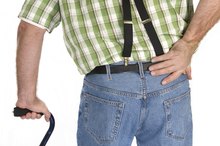Sciatica & Weight Loss
Sciatica is the common name for pain from irritated nerves along the low back, legs and feet. Along with pain, there may be associated numbness and weakness. Sciatica is so common that entire medical specialties are dedicated to diagnosing and treating it. Nerve pain from sciatica can affect any race, gender and age group. Sciatica pain is a symptom of an underlying medical problem, and weight loss can ease the pain.
Sciatica's Causes
Sciatica symptoms refer to pain, numbness and weakness in the low back and legs supplied by the sciatic nerve. The origins of the left and right sciatic nerves are the body's spinal cord. The nerves start in the spinal cord at the L3, L4, L5 and S1 levels. From there, they travel to the bottom of the feet. Sciatica pain can occur anywhere along that path. Usually, the sensation is mixed: pain in one part of the back or legs and numbness in another part of the legs. The most common causes of sciatica are a narrowing of the spinal canal, a herniated disk in the back or an irritation along the nerve path by muscle or joint inflammation.
- Sciatica symptoms refer to pain, numbness and weakness in the low back and legs supplied by the sciatic nerve.
- The origins of the left and right sciatic nerves are the body's spinal cord.
Effect of Body Weight
What Are the Causes of Sharp Shooting Hip Pain Running Down Leg?
Learn More
In general, any force that puts more pressure on the low back and pelvis will make the symptoms of sciatica worse. A 2005 study reported in "Arthritis & Rheumatism" indicated that every extra pound of body weight adds 4 pounds of compression force on the joints and back. Patients who are obese may take longer to heal from sciatica, and their healing will be less than nonobese patients because of the physical stresses on tissues. These observations are true whether the sciatica is treated using surgery or nonsurgical methods. Manual laborers and machine operators who perform repetitive heavy lifting are more prone to developing sciatica. High-impact athletics such as football can also promote sciatica pain.
- In general, any force that puts more pressure on the low back and pelvis will make the symptoms of sciatica worse.
- Patients who are obese may take longer to heal from sciatica, and their healing will be less than nonobese patients because of the physical stresses on tissues.
Weight Loss and Exercise
Losing weight is beneficial for sciatica sufferers. It doesn't take much weight loss to begin reducing inflammation and abnormal stress on the injured tissue. Massages and heat help reduce the back spasms often associated with sciatica. A structured weight program is best at the beginning since that is where the greatest progress is usually seen. Exercising while in pain is also challenging, but it will help sciatica pain. Often, when a patient has a back injury that just recently occurred, she will be sent to therapy to start immediate structured treatment.
- Losing weight is beneficial for sciatica sufferers.
- Exercising while in pain is also challenging, but it will help sciatica pain.
Structured Therapy
What Causes Pain When Performing Leg Raises?
Learn More
Often a reason for weight gain is the sciatica sufferer can't exercise enough due to pain. The increase in weight then leads to worsening sciatica pain and more immobility and further weight gain. A goal of pain management and therapy is to break this cycle so that the sciatica sufferer can resume his normal life. In addition to helping the patient lose weight, a therapist will have specific goals: pain control, swelling reduction, increase range of motion, strengthening, teaching proper body mechanics, improving coordination and balance, and protection against reinjury.
- Often a reason for weight gain is the sciatica sufferer can't exercise enough due to pain.
Related Articles
References
- Arthritis & Rheumatism: Weight Loss Reduces Knee-Joint Loads in Overweight and Obese Older Adults With Knee Osteoarthritis
- Journal of Bone and Joint Surgery: The Influence of Obesity on the Outcome of Treatment of Lumbar Disc Herniation
- Physical Medicine and Rehabilitation Clinics of North America: Physical Agents Used in the Management of Chronic Pain by Physical Therapists
- Davis D, Maini K, Vasudevan A. Sciatica. [Updated 2020 Jan 25]. In: StatPearls [Internet]. Treasure Island (FL): StatPearls Publishing; 2020 Jan-. Available from: https://www.ncbi.nlm.nih.gov/books/NBK507908/
- Giuffre BA, Jeanmonod R. Anatomy, Sciatic Nerve. [Updated 2020 Mar 11]. In: StatPearls [Internet]. Treasure Island (FL): StatPearls Publishing; 2020 Jan-. Available from: https://www.ncbi.nlm.nih.gov/books/NBK482431/
- Davis D, Maini K, Vasudevan A. Sciatica. [Updated 2020 Jan 25]. In: StatPearls [Internet]. Treasure Island (FL): StatPearls Publishing; 2020 Jan-.
- Giuffre BA, Jeanmonod R. Anatomy, Sciatic Nerve. [Updated 2020 Mar 11]. In: StatPearls [Internet]. Treasure Island (FL): StatPearls Publishing; 2020 Jan-.
- National Institute of Neurological Disorders and Stroke. Low Back Pain Fact Sheet. Updated August 13, 2019. ninds.nih.gov
- Verwoerd AJH, Mens J, El Barzouhi A, Peul WC, Koes BW, Verhagen AP. A diagnostic study in patients with sciatica establishing the importance of localization of worsening of pain during coughing, sneezing and straining to assess nerve root compression on MRI. Eur Spine J. 2016;25(5):1389–1392. doi:10.1007/s00586-016-4393-8
- Koes BW, van Tulder MW, Peul WC. Diagnosis and treatment of sciatica. BMJ. 2007;334(7607):1313–1317. doi:10.1136/bmj.39223.428495.BE
- Chen MR, Wang P, Cheng G, Guo X, Wei GW, Cheng XH. The warming acupuncture for treatment of sciatica in 30 cases. Journal of Traditional Chinese Medicine 2009 29(1):50-3.
- Lawrence DJ, Meeker W, Branson R, Bronfort G, Cates JR, Haas M, Haneline M, Micozzi M, Updyke W, Mootz R, Triano JJ, Hawk C. Chiropractic management of low back pain and low back-related leg complaints: a literature synthesis. Journal of Manipulative and Physiological Therapeutics 2008 31(9):659-74. doi:10.1016/j.jmpt.2008.10.007
- Bell J. Massage therapy helps to increase range of motion, decrease pain and assist in healing a client with low back pain and sciatica symptoms. Journal of Bodywork and Movement Therapies 2008 12(3):281-9. doi:10.1016/j.jbmt.2008.01.006
Writer Bio
Dr. Kamel Ghandour is assistant professor of medicine at Quinnipiac University School of Medicine. He has been writing for 10 years, contributing to such publications as the "Journal of Clinical Anesthesia" and the journal "Anesthesia & Analgesia." He specializes in anesthesia and pain medicine.









